Link to YouTube Video giving an overview of a hybrid system
A hybrid vehicle can achieve propulsion using a fuelled power source (e.g. a diesel engine) or through a stored energy source (e.g. a battery bank and electric motor).
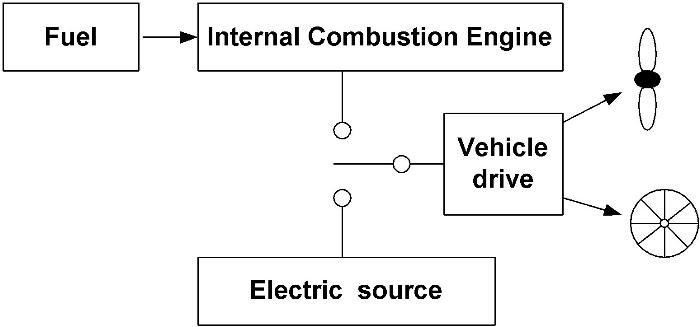
There are three basic Hybrid configurations (with many variations), Diesel/Electric, Serial hybrid & Parallel Hybrid
Diesel/Electric
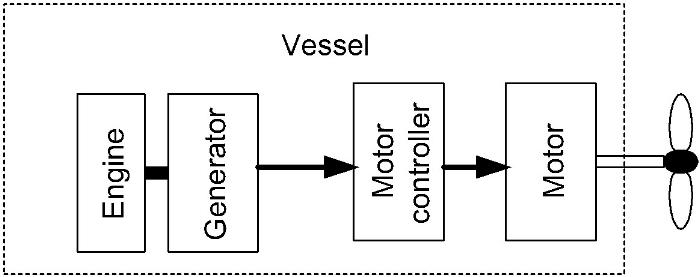
The engine (e.g. petrol or diesel) is connected directly to an electrical generator. From this point on the power in the system is transferred electrically to the propeller shaft via a motor controller and electric motor. The system may have multiple generators and multiple motors connected to a common electrical bus. This technology is used in diesel/electric trains and many large ships such as the Queen Mary 2. By the strict definition this is not a hybrid as there is no electric storage of energy.
Serial Hybrid
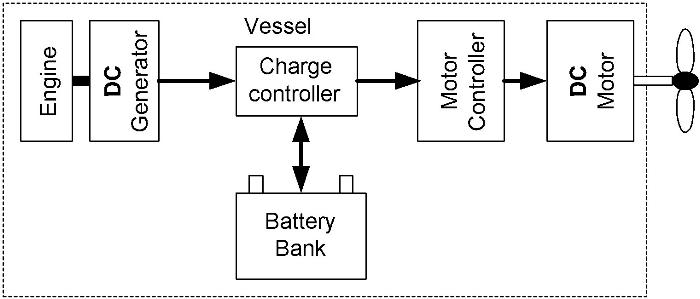
The serial hybrid is similar to the Diesel/Electric in that it breaks the mechanical connection between the engine and propeller shaft. However a battery bank is also connected to the common electric power buss. In this system you can stop the engine and use the stored energy in the battery bank. With large batteries you can have long periods of electric propulsion (and/or driving onboard electrical appliances) without resorting to the generator.
Parallel Hybrid
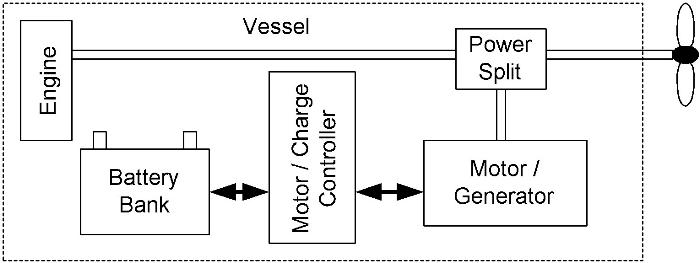
A parallel hybrid maintains the mechanical connection between the engine and propeller shaft. As it's name implies the electric motor acts on the drive shaft in parallel with the engine. The Power split is a mechanical device that allows transfer of power between its connections. You can drive the propeller directly from the engine or from the electric motor or from both. You can also disconnect the propeller for a stand-alone generator function. During re-generation the engine is disconnected.
How can a hybrid improve fuel consumption ?
To understand this we must first consider a typical power graph for a vessel.
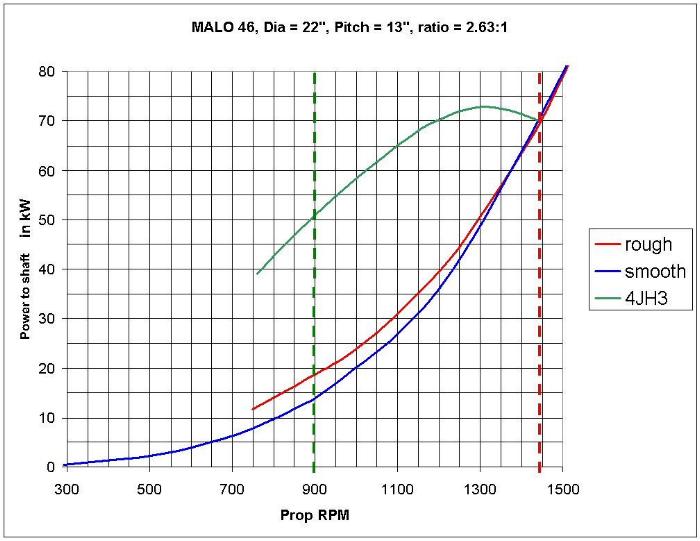
The Red and Blue lines show the power demanded by the propeller (in rough and smooth water respectively) when it is turned at varying shaft speeds.
The green line is the maximum power the engine is able to supply at the varying shaft speeds. Note : the gear box ratio is 2.63:1 so maximum speed for this engine is 3,900RPM.
If the propeller is correctly selected then it should allow the engine to reach it's maximum RPM while loading it to it's maximum output power capability, this operating point is indicated by the red dotted vertical line. As can be seen from the graph the propeller is well matched and the engine is fully loaded at it's maximum RPM. This is the point were the engine and propeller curves cross and represents maximum vessel speed for this engine/propeller combination.
In practice the engine would rarely be operated at full power for prolonged periods. A typical cruising speed may be around 900RPM at the shaft (shown by the green dotted vertical line). In smooth water conditions the power required by the propeller is around 14kW while the engine is capable of supplying 51kW. The engine is thus lightly loaded and runs without effort.
The efficiency of an engine can be thought of as it's ability to turn fuel into mechanical energy at the drive shaft. An engine generally operates with it's highest efficiency when fully loaded. As you reduce the load on the engine it' efficiency drops. This can best be understood by considering the engine operating out of gear. In neutral you can rev the engine to any speed, it will burn fuel yet the shaft does not turn, efficiency here is zero ! If you now put it in forward gear and increase the load on the engine then a portion of the fuel used goes to providing useful power. The larger the load the greater the percentage of fuel used goes to providing power at the shaft.
Going back to the graph, we can see at cruising speed the engine is lightly loaded and thus running with a lower efficient than it can achieve at higher loads. This is where a hybrid can help, by playing a few tricks it can operate the engine with higher efficiency. The two fundamental methods used to improve overall efficiency are Engine cycling and Energy buffering.
Engine cycling
Imagine we are in a car and driving in 2nd gear at 30MPH on the flat. We have a situation were the engine is revving fast under low load, (this equates to our yacht operating at cruising speed). We are burning lots of fuel and our MPG would be low. In a car we would instinctively go up a few gears to 4th. For the same road speed the engine would then be turning at a slower RPM. It can be seen from the power graph that an engine's ability to provide power reduces with it'sspeed of rotation. It takes the same power to move the car at 30MPH regardless of the gear selected. So changing gear has narrowed the gap between the amount of power the engine can supply (at that particular RPM) and the power demanded from it. This loads the engine closer to the maximum power curve and thus increased it's efficiency, we see this in an improved MPG.
So in our boat all we need to do when cruising is to change up a few gears to improve fuel economy! Not quite as ridiculous as it sounds as there are some two speed boxes for fast plaining craft. In our standard diesel engine craft we have only one forward gear. However in a Serial Hybrid or Diesel/Electric system we have mechanically disconnected the engine from the propeller. We can now vary the engine speed to match the power required by the craft, the electronics then converts this power to the voltage/current required by the motor to drive the shaft. Our electric transmission of power from engine to shaft performs the function of a continuously variable gear box. So our hybrid gives us the ability to change gear and provides the same improvements in fuel economy as we see for the car.
Engine cycling (that is varying it's speed according to the load) is one way a hybrid can improve engine efficiency. This cycling is normally performed automatically by an intelligent control system.
Energy buffering.
If the power requirement is low then regardless of the engine speed it can not be operated efficiently. Energy buffering can help here. A hybrid can extract from the engine a higher power than required by propulsion. The extra energy supplied can then be stored (buffered) in the battery bank. Once the batteries are full you can turn the engine off and provide the low propulsion power demand with pure electric drive. When the batteries become depleted then you turn the engine back on again. The engine is thus operated in stop/start cycles and when it is running it is operating under a substantial load, this results in higher overall efficiency.
We can now establish a few rules that will enable a basic understanding of hybrids :
1) An Engine under low load operates with lower efficiency than when under a higher load.
2) At top speed, provided you have a properly matched propeller, the engine is operating with it's highest efficiency.
3) At cruising speed the engine is usually lightly loaded and thus operating with poor efficiency.
4) Hybrids can help improve efficiency at cruising speed by engine cycling or buffering the energy from the engine and returning this to the drive shaft at a later time.
5) A hybrid can only improve overall efficiency if the losses incurred in the storage and return of energy is less than the improvements made in engine operating efficiency. This is a very important point as not every hybrid design can achieve this and some can even end up being less efficient than a standard diesel!
6) This is a very simplistic discussion and is intended only to convey the basic principles to a wide audience. If you are a mechanical engineer then please don't flood me with corrections or additions !!
Which is the best Hybrid ?
There are many hybrid variations and this is not an easy question to answer. To a large extent it depends on the type of craft and how you intend to use it.
For example lets say you have an auxiliary sailing vessel with a 100hp diesel installed and you want to replace this engine with a hybrid. You want to have improvements in fuel economy when cruising but still require 100hp max power for emergencies.
What about a serial Hybrid ?
With reference to the drawings above you may select a serial hybrid system. There will be losses in the electric generator, batteries, motor controller and motor. If you still require the same max power at the shaft then the engine needs to be bigger than 100hp to account for these losses. The generator, motor controller and motor need to transmit the full 100hp and this makes them large and expensive items.
From rule 2) above it can be seen that at full power the engine is operating with relatively high efficiency so the hybrid can not provide any improvements here. However to get the same max operating power you have sized the electrical components to operate at maximum engine power where the hybrid does not give any benefits. There is a very high price to pay for this (literally) and explains why serial hybrid systems can be very expensive.
What about a Parallel hybrid?
In a parallel Hybrid system the motor & generator functions can be combined in one unit saving weight and cost. The electric drive components are sized to the operating power where they can provide the most benefit, that is : low to mid speed cruising. Maximum power is supplied directly by the engine and the hybrid keeps out of the way. A Parallel Hybrid thus give improved efficiency at high power compared to a Serial Hybrid.
A parallel Hybrid is also intrinsically more reliable than a serial system. If an electronic component breaks down then this would disable a Serial system. If a parallel hybrid breaks down then the engine can go on happily providing propulsion in the usual way.
As the electric components are smaller and lighter then a parallel hybrid can be considerably lower in cost than a serial system. This provides a good cost/feature trade off and is why as a company we have decided to concentrate on developing parallel hybrid systems.
Interested in knowing more about Hybrids ?
I have co-authored a series of three articles with the Marine journalist Nigel Calder. These cover hybrid principles in more depth. You can view these articles on line by going to http://proboat.com and viewing back issues of Profesional Boat Builder for June/July 07 (page 82), Aug/Sept 07(page 82) and Oct/Nov(page 140). You will need to register with them but it is for free !
Take a look at our Production System